基于频率响应的传递函数辨识
电力系统稳定性分析中的频率响应辨识方法研究
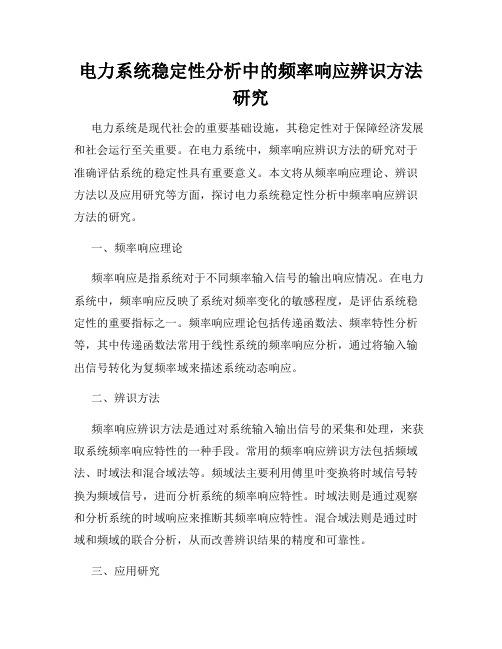
电力系统稳定性分析中的频率响应辨识方法研究电力系统是现代社会的重要基础设施,其稳定性对于保障经济发展和社会运行至关重要。
在电力系统中,频率响应辨识方法的研究对于准确评估系统的稳定性具有重要意义。
本文将从频率响应理论、辨识方法以及应用研究等方面,探讨电力系统稳定性分析中频率响应辨识方法的研究。
一、频率响应理论频率响应是指系统对于不同频率输入信号的输出响应情况。
在电力系统中,频率响应反映了系统对频率变化的敏感程度,是评估系统稳定性的重要指标之一。
频率响应理论包括传递函数法、频率特性分析等,其中传递函数法常用于线性系统的频率响应分析,通过将输入输出信号转化为复频率域来描述系统动态响应。
二、辨识方法频率响应辨识方法是通过对系统输入输出信号的采集和处理,来获取系统频率响应特性的一种手段。
常用的频率响应辨识方法包括频域法、时域法和混合域法等。
频域法主要利用傅里叶变换将时域信号转换为频域信号,进而分析系统的频率响应特性。
时域法则是通过观察和分析系统的时域响应来推断其频率响应特性。
混合域法则是通过时域和频域的联合分析,从而改善辨识结果的精度和可靠性。
三、应用研究在电力系统中,频率响应辨识方法的研究在很多方面具有广泛应用。
首先,频率响应辨识方法可以用于评估电力系统的稳定性,并为系统运行提供参考依据。
其次,通过频率响应辨识方法,可以分析系统中的潜在问题,提前进行预警和干预,以避免发生事故或故障。
此外,频率响应辨识方法还可用于电力系统的优化控制,提高系统的运行效率和可靠性。
为了实现对电力系统稳定性分析中频率响应辨识方法的研究,研究者们提出了许多改进和创新的方法。
例如,使用自适应算法和机器学习技术,可以提高频率响应的辨识准确度和鲁棒性。
同时,结合智能传感器和物联网技术,可以实现对电力系统实时频率响应的在线监测和分析。
综上所述,电力系统稳定性分析中的频率响应辨识方法的研究对于保障电力系统的安全稳定运行具有重要意义。
通过频率响应辨识方法,可以评估系统的稳定性,预测系统可能存在的问题,并采取措施提高系统的可靠性和运行效率。
频率响应函数是传递函数的特例

系统分析中的三类问题:
1)当输入、输出是可测量的(已知),可以通过它 们推断系统的传输特性。 (系统辨识) 3)当系统特性已知,输出可测量,可以通过它 们推断导致该输出的输入量。 (反求)
3)如果输入和系统特性已知,则可以推断和估 计系统的输出量。(预测)
三峡大学机械与材料学院
测试系统基本要求
理想的测试系统应该具有单值的、确定的输 入-输出关系。对于每一输入量都应该只有单一 的输出量与之对应。知道其中一个量就可以确定 另一个量。其中以输出和输入成线性关系最佳。
三峡大学机械与材料学院
1.线性定常系统及其主要性质 系统输入x(t)和输出y(t)间的关系可以用常系 数线性微分方程来描述:
d n y(t) d n -1 y(t) dy(t) an + a n -1 + a1 + a 0 y( t ) n n -1 dt dt dt m m -1 d x(t) d x(t) dx(t) bm + b m-1 + b1 + b 0 x( t ) m m -1 dt dt dt
3.1 测试系统静态响应特性
三峡大学机械与材料学院
b)非线性度 标定曲线与拟合直线的偏离程度就是非线性度。 B F= 100% A
c)回程误差
测试装置在输入量由小增大和由大减小的 测试过程中,对于同一个输入量所得到的两个 数值不同的输出量之间差值最大者为 hmax ,则 定义回程误差为 回程误差=(hmax/A)×100%
3.1 测试系统静态响应特性
三峡大学机械与材料学院
d) 静态响应特性的其他描述 精度:是与评价测试装置产生的测量误差大小有 关的指标。
灵敏阈:又称为死区,用来衡量测量起始点不灵 敏的程度。 分辨力:指能引起输出量发生变化时输入量的最 小变化量,表明测试装置分辨输入量微小变化的 能力。 测量范围:是指测试装置能正常测量最小输入量 和最大输入量之的范围。
传递函数和频率响应函数的概念
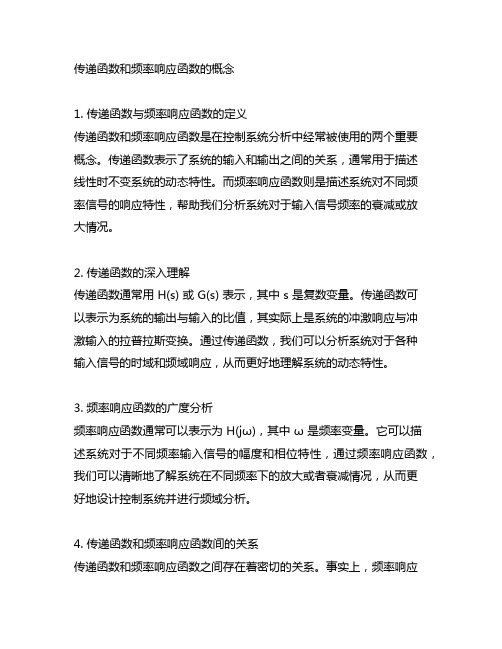
传递函数和频率响应函数的概念1. 传递函数与频率响应函数的定义传递函数和频率响应函数是在控制系统分析中经常被使用的两个重要概念。
传递函数表示了系统的输入和输出之间的关系,通常用于描述线性时不变系统的动态特性。
而频率响应函数则是描述系统对不同频率信号的响应特性,帮助我们分析系统对于输入信号频率的衰减或放大情况。
2. 传递函数的深入理解传递函数通常用 H(s) 或 G(s) 表示,其中 s 是复数变量。
传递函数可以表示为系统的输出与输入的比值,其实际上是系统的冲激响应与冲激输入的拉普拉斯变换。
通过传递函数,我们可以分析系统对于各种输入信号的时域和频域响应,从而更好地理解系统的动态特性。
3. 频率响应函数的广度分析频率响应函数通常可以表示为H(jω),其中ω 是频率变量。
它可以描述系统对于不同频率输入信号的幅度和相位特性,通过频率响应函数,我们可以清晰地了解系统在不同频率下的放大或者衰减情况,从而更好地设计控制系统并进行频域分析。
4. 传递函数和频率响应函数间的关系传递函数和频率响应函数之间存在着密切的关系。
事实上,频率响应函数可以通过传递函数来得到,通过传递函数的极点和零点,我们可以清晰地了解系统对于不同频率信号的响应情况,从而利用频率响应函数来优化系统的控制性能。
5. 个人观点和理解对于传递函数和频率响应函数的理解,我认为它们是控制系统分析和设计中非常重要的概念。
通过对传递函数和频率响应函数的深入理解,我们可以更好地了解系统的动态特性,在控制系统设计中更加灵活地选择合适的控制策略。
频率响应函数还可以帮助我们进行系统的稳定性分析和频域设计,对于系统的性能指标如稳定裕度、相位裕度等有着重要的指导意义。
总结回顾传递函数和频率响应函数作为控制系统分析中的重要概念,对于系统的动态特性和频域特性有着深刻的影响。
通过对传递函数和频率响应函数的分析,我们可以更好地理解系统的动态响应和频率特性,从而更好地设计和优化控制系统。
[转载]传递函数、频响函数、脉冲响应函数
![[转载]传递函数、频响函数、脉冲响应函数](https://img.taocdn.com/s3/m/bdf36108fe00bed5b9f3f90f76c66137ee064f6b.png)
[转载]传递函数、频响函数、脉冲响应函数
原⽂地址:传递函数、频响函数、脉冲响应函数作者:moneybolight
/forum.php?mod=viewthread&tid=101444&page=1
传递函数:零初始条件下线性系统响应(即输出)量的拉普拉斯变化(或z变换)与激励(即输⼊)量的拉普拉斯变换之⽐。
记作G(s)=Y(s)/U(s),其中Y(s)、U(s)分别为输出量和输⼊量的拉普拉斯变换。
频响函数:(1)简谐激励时,稳态输出相量与输⼊相量之⽐。
(2)瞬态激励时,输出的傅⾥叶变换与输⼊的傅⾥叶变换之⽐。
(3)平稳随机激励时,输出和输⼊的互谱与输⼊的⾃谱之⽐。
脉冲响应函数(或叫脉冲响应)⼀般是指系统在输⼊为单位脉冲函数时的输出(响应)。
对于连续时间系统来说,冲激响应⼀般⽤函数h(t)来表⽰。
对于⽆随机噪声的确定性线性系统,当输⼊信号为⼀脉冲函数δ(t)时,系统的输出响应 h(t)称为脉冲响应函数。
传递函数,频率响应函数均是描述线性系统动态特性的基本数学⼯具之⼀,都是建⽴在传递函数的基础之上。
但传递函数是系统的物理参数,也就是它受硬件决定,不会随着输⼊变化⽽变化,是分析系统的⼀个数学公式,⽽频率响应函数是输出函数,也就是说系统的传递函数乘上输⼊的信号,⽽得到的频率响应函数(当然是在频域中分析)。
14-1传递函数与频率响应

2018/10/5
有缘学习更多+谓ygd3076考证资料或关注桃报:奉献教育(店铺) 7
本讲小结
频率响应,是指正弦稳态电路的行为,随激励频率的变化规律,用 传递函数来描述。
传递函数定义为:输出相量和输入相量的比值。 幅频响应——传递函数的模值,体现输出与输入幅值之比,随频 率的变化规律。 相频响应——传递函数的相位,体现输出与输入初相之差,随频 频率的变化规律。
传递函数2018105华中科技大学电气与电子工程学院颜秋容教授幅频响应曲线相频响应曲线幅频响应相频响应crcr2018105华中科技大学电气与电子工程学院颜秋容教授0707分析频率响应的意义频率选择性对高频信号有抑制作用为低通滤波器
电路理论
传递函数与频率响应
传递函数与频率响应
正弦稳态响应:
j 1
Uo
Us -
+
j 1
C
+ R Uo
高通滤波器
-
R
+
+
Us -
j 1
C 低通滤波器
Uo
-
幅频响应
H () Uo
Us
R RC
R 1
1 (RC)2
jC
H (0) 0
H () 1
H (c ) 0.707
c 1 RC
幅频响应曲线 H ()
1
0.707
o c 1 RC
频率选择性 对低频信号有抑制作用,为高
分析频率响应的意义在于:掌握电路对信号频率的选择性。
2018/10/5
8
R
C
j 1
Us
C
1
1 jCR Us
+
Us Uss
传递函数辨识(2):脉冲响应两点法和三点法
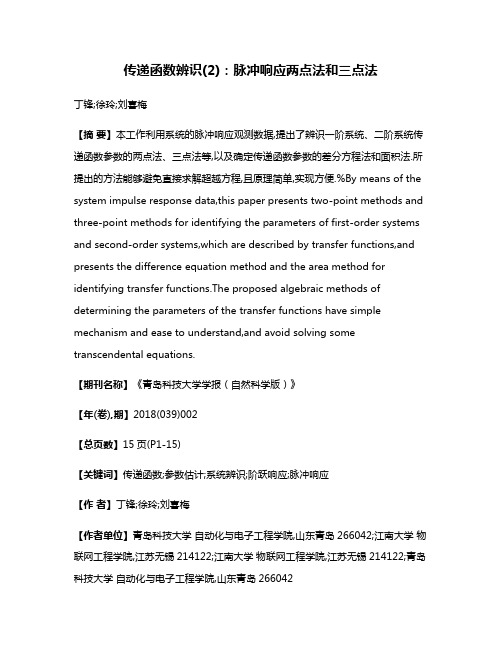
传递函数辨识(2):脉冲响应两点法和三点法丁锋;徐玲;刘喜梅【摘要】本工作利用系统的脉冲响应观测数据,提出了辨识一阶系统、二阶系统传递函数参数的两点法、三点法等,以及确定传递函数参数的差分方程法和面积法.所提出的方法能够避免直接求解超越方程,且原理简单,实现方便.%By means of the system impulse response data,this paper presents two-point methods and three-point methods for identifying the parameters of first-order systems and second-order systems,which are described by transfer functions,and presents the difference equation method and the area method for identifying transfer functions.The proposed algebraic methods of determining the parameters of the transfer functions have simple mechanism and ease to understand,and avoid solving some transcendental equations.【期刊名称】《青岛科技大学学报(自然科学版)》【年(卷),期】2018(039)002【总页数】15页(P1-15)【关键词】传递函数;参数估计;系统辨识;阶跃响应;脉冲响应【作者】丁锋;徐玲;刘喜梅【作者单位】青岛科技大学自动化与电子工程学院,山东青岛266042;江南大学物联网工程学院,江苏无锡214122;江南大学物联网工程学院,江苏无锡214122;青岛科技大学自动化与电子工程学院,山东青岛266042【正文语种】中文【中图分类】TP273传递函数是一种参数模型。
传递函数辨识(9):基于频率响应的递推参数估计方法
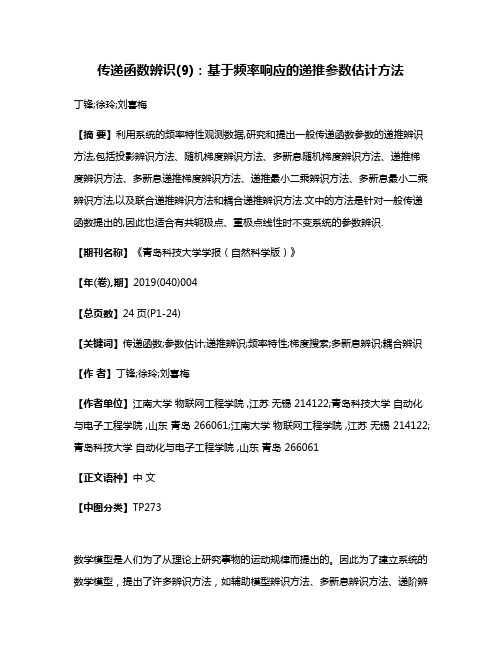
传递函数辨识(9):基于频率响应的递推参数估计方法丁锋;徐玲;刘喜梅【摘要】利用系统的频率特性观测数据,研究和提出一般传递函数参数的递推辨识方法,包括投影辨识方法、随机梯度辨识方法、多新息随机梯度辨识方法、递推梯度辨识方法、多新息递推梯度辨识方法、递推最小二乘辨识方法、多新息最小二乘辨识方法,以及联合递推辨识方法和耦合递推辨识方法.文中的方法是针对一般传递函数提出的,因此也适合有共轭极点、重极点线性时不变系统的参数辨识.【期刊名称】《青岛科技大学学报(自然科学版)》【年(卷),期】2019(040)004【总页数】24页(P1-24)【关键词】传递函数;参数估计;递推辨识;频率特性;梯度搜索;多新息辨识;耦合辨识【作者】丁锋;徐玲;刘喜梅【作者单位】江南大学物联网工程学院 ,江苏无锡 214122;青岛科技大学自动化与电子工程学院 ,山东青岛 266061;江南大学物联网工程学院 ,江苏无锡 214122;青岛科技大学自动化与电子工程学院 ,山东青岛 266061【正文语种】中文【中图分类】TP273数学模型是人们为了从理论上研究事物的运动规律而提出的。
因此为了建立系统的数学模型,提出了许多辨识方法,如辅助模型辨识方法、多新息辨识方法、递阶辨识方法、耦合辨识方法、滤波辨识方法等[1-4]。
一些辨识方法可进一步发展用于信号模型的参数估计和传递函数的参数估计[5-7]。
在自动控制理论中,频率特性的定义如下。
对于线性定常系统,在零初始条件下,当输入信号的频率为ω,如输入是角频率为ω的正弦信号,系统的稳态输出也是一个同角频率但相位滞后的正弦信号,系统稳态输出的幅值与输入信号的幅值之比随输入信号频率的变化规律称为幅频特性,系统稳态输出的相位与输入信号的相位之差随输入信号频率的变化规律称为相频特性。
简单地说,就是幅值和相位与角频率ω的函数关系。
系统的频率特性是幅频特性与相频特性的统称。
一般角频率在0→∞的范围内取值。
压电式快速反射镜系统建模与传递函数辨识
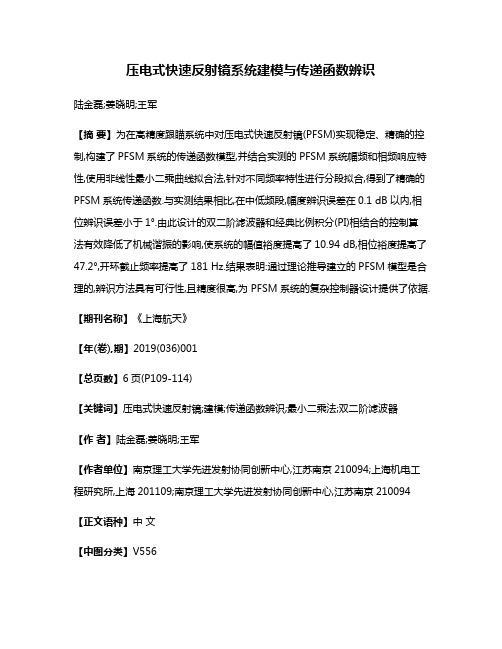
压电式快速反射镜系统建模与传递函数辨识陆金磊;姜晓明;王军【摘要】为在高精度跟瞄系统中对压电式快速反射镜(PFSM)实现稳定、精确的控制,构建了PFSM系统的传递函数模型,并结合实测的PFSM系统幅频和相频响应特性,使用非线性最小二乘曲线拟合法,针对不同频率特性进行分段拟合,得到了精确的PFSM系统传递函数.与实测结果相比,在中低频段,幅度辨识误差在0.1 dB以内,相位辨识误差小于1°.由此设计的双二阶滤波器和经典比例积分(PI)相结合的控制算法有效降低了机械谐振的影响,使系统的幅值裕度提高了10.94 dB,相位裕度提高了47.2°,开环截止频率提高了181 Hz.结果表明:通过理论推导建立的PFSM模型是合理的,辨识方法具有可行性,且精度很高,为PFSM系统的复杂控制器设计提供了依据.【期刊名称】《上海航天》【年(卷),期】2019(036)001【总页数】6页(P109-114)【关键词】压电式快速反射镜;建模;传递函数辨识;最小二乘法;双二阶滤波器【作者】陆金磊;姜晓明;王军【作者单位】南京理工大学先进发射协同创新中心,江苏南京210094;上海机电工程研究所,上海201109;南京理工大学先进发射协同创新中心,江苏南京210094【正文语种】中文【中图分类】V5560 引言压电式快速反射镜(PFSM)采用压电叠堆作为驱动器[1],具有体积小、响应快、精度高、动态性能好等优点,在自适应光学[2]、图像稳定系统[3-4]、目标跟踪系统[5-6]、生物医学系统[7]等领域具有广泛的应用前景。
本文将PFSM应用在光电精密跟踪系统中,将其作为复合轴子系统的执行机构,主要用于校正机架主系统的随机误差。
为稳定跟踪目标,光电跟瞄系统的精度需要达到微弧度级,这对PFSM 的控制精度提出了很高要求。
对于控制设计者来说,如何获得被控对象的精准数学模型极为关键。
目前,常用的传递函数参数辨识方法主要包括时域阶跃响应法和频域频率响应法。
- 1、下载文档前请自行甄别文档内容的完整性,平台不提供额外的编辑、内容补充、找答案等附加服务。
- 2、"仅部分预览"的文档,不可在线预览部分如存在完整性等问题,可反馈申请退款(可完整预览的文档不适用该条件!)。
- 3、如文档侵犯您的权益,请联系客服反馈,我们会尽快为您处理(人工客服工作时间:9:00-18:30)。
IDMEC/IST, Technical University of Lisbon,
Avenida Rovisco Pais, 1049-001 Lisboa, Portugal e-mail: dvalerio@dem.ist.utl.pt
Manuel Duarte Ortigueira
m
͚ ␣͑͒ = bk Re͓͑j͒kq͔ k=0
n
n
͚ ͚ ͑͒ = ak Re͓͑j͒kq͔ = 1 + ak Re͓͑j͒kq͔
k=0
k=1
m
͑3͒
͚ ͑͒ = bk Im͓͑j͒kq͔
k=0
n
n
͚ ͚ ͑͒ = ak Im͓͑j͒kq͔ = ak Im͓͑j͒kq͔
Contributed by the Design Engineering Division of ASME for publication in the JOURNAL OF COMPUTATIONAL AND NONLINEAR DYNAMICS. Manuscript received June 6, 2007; final manuscript received November 30, 2007; published online February 4, 2008. Review conducted by J. A. Tenreiro Machado. Paper presented at the ASME 2007 Design Engineering Technical Conferences and Computers and Information in Engineering Conference ͑DETC2007͒, Las Vegas, NV, September 4–7, 2007.
Journal of Computational and Nonlinear Dynamics Copyright © 2008 by ASME
APRIL 2008, Vol. 3 / 021207-1
Downloaded 08 Nov 2011 to 211.68.3.254. Redistribution subject to ASME license or copyright; see /terms/Terms_Use.cfm
denominator, and q is the fractional derivative order. Without loosing generality, we set a0 = 1. The frequency response of ͑1͒ is given by
Gˆ ͑j͒
=
1
͚km=0bk͑ j͒kq + ͚kn=1ak͑j͒kq
Gˆ ͑s͒
=
b0 + b1sq + b2s2q + a0 + a1sq + a2s2q +
¯ ¯
+ bmsmq + ansnq
=
͚km=0bkskq ͚kn=0akskq
͑1͒
where m and n are the preassigned orders of the numerator and
def
E͑j͒ = ⑀͑j͒D͑j͒ = G͑j͒D͑j͒ − N͑j͒
͑5͒
This leads to a set of normal equations, easy to solve. Omitting the frequency argument to simplify the notation, we have
Here, we reformulate the original approach in a completely complex framework, leading to a set of normal equations from which we could remove the frequency dependency. Expressions obtained are shorter. Thus, we obtain two sets of linear equations for each frequency. The formulation is given for the general case of a fractional, commensurate transfer function.
Introduction
The identification of linear systems is an interesting subject that deserved a lot of attention in the past ͓1͔. Identification in the frequency domain is a particular case with great interest in applications. Algorithms are traditionally based on Levy’s work ͓2͔, a least-squares based algorithm formulated in a real framework by separating the real and imaginary parts of the transfer function. This led to a formulation with lengthy expressions and to results not equally good at all frequencies ͓3͔. This frequency dependence has been faced ͓3͔ by using an iterative method; another alternative, without iterations, was also proposed ͓4͔. Both adaptations modify the basic algorithm introducing weights.
In this paper, the classic Levy identification method is reviewed and reformulated using a complex representation. This new formulation addresses the well known bias of the classic method at low frequencies. The formulation is generic, coping with both integer order and fractional order transfer functions. A new algorithm based on a stacked matrix and its pseudoinverse is proposed to accommodate the data over a wide range of frequencies. Several simulation results are presented, together with a real system identification. This system is the Archimedes Wave Swing, a prototype of a device to convert the energy of sea waves into electricity. ͓DOI: 10.1115/1.2833906͔
The use of measurements corresponding to several frequencies has been addressed in the past by an average of the coefficients computed from each frequency. This procedure is neither robust nor sensible to order changes. To obtain a more reliable algorithm, we propose a new algorithm with two steps: firstly, collect the matrices corresponding to the different frequencies in a stacked matrix; secondly, compute the coefficients of the model by using the pseudoinverse. To illustrate the behavior of this new formulation, we present some simulation results and also a real practical example.
=
N͑j͒ D͑j͒
=
␣͑͒ ͑͒
+ +
j͑͒ j͑͒
͑2͒
where N and D are complex valued and ␣, , , and ͑the real and imaginary parts thereof͒ are real valued. From ͑2͒ we see that
Adapting Levy’s Identification Method for Fractional Orders
Original Formulation. Let us suppose we have a plant described by a linear system with a transfer function G and a corresponding frequency response G͑j͒ and that we want to model it using a transfer function
